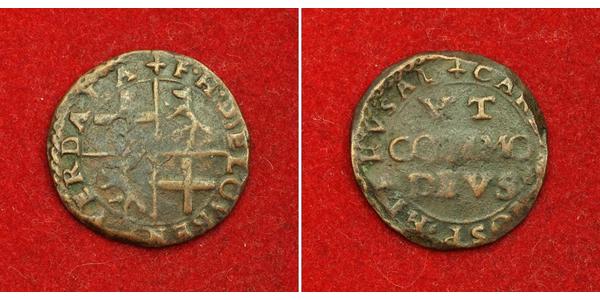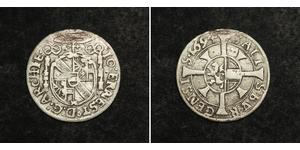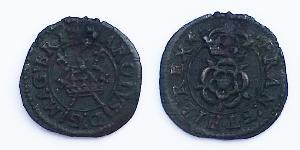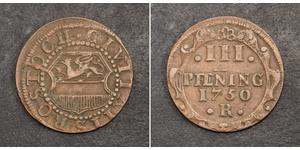(Vendue pour $216.0)
1595, Knights of Malta, Hugues Loubenx de Verdalle. Scarce Copper Grano Coin.
Condition: VF-
Mint Place: Valetta
Denomination: Grano
Mint Period: 1582-1595
Reference: Restelli 57 (R2!).
Material: Copper
Diameter: 20mm
Weight: 2.77gm
Obverse: Shield with arms of the Grand Master. Legend around.
Legend: +F.H.DE LOVBENS VERDALA
Reverse: Inscription (VT / COMMO / DIVS) within inner circle.
Legend: +CARD.M.HOSP.HERVSAL
Fra' Hugues Loubenx de Verdalle (13 April 1531 – 4 May 1595) was the 52nd Grand Master of the Order of Malta, between 1582 and 1595. He is mainly remembered for the reconstruction of the hunting lodge at Boschetto which was renamed Verdala Palace in his honour. He is buried in a sarcophagus in the Crypt of the Co-Cathedral of St. John in Valletta. He was made Cardinal-Deacon of S. Maria in Portico Octaviae by Pope Sixtus V in the consistory of December 18, 1587.
The Knights Hospitaller (also known as the Sovereign Military Hospitaller Order of St. John of Jerusalem of Rhodes and of Malta, Order of St. John, Knights of Malta, and Chevaliers of Malta; French: Ordre des Hospitaliers, Maltese: Ordni ta' San Gwann) was a Christian organization that began as an Amalfitan hospital founded in Jerusalem in 1080 to provide care for poor, sick or injured pilgrims to the Holy Land. After the Western Christian reconquest of Jerusalem in 1099 during the First Crusade it became a religious/military order under its own charter, and was charged with the care and defense of the Holy Land. Following the conquest of the Holy Land by Islamic forces, the Order operated from Rhodes, over which it was sovereign, and later from Malta where it administered a vassal state under the Spanish viceroy of Sicily.
The Order lost many of its European holdings following the rise of Protestantism and French Egalitarianism, but survived on Malta. The property of the English branch was confiscated in 1540. In 1577, the German Bailiwick of Brandenburg became Lutheran, but continued to pay its financial contribution to the Order until the branch was turned into a merit Order by the King of Prussia in 1812. The "Johanniter Orden" was restored as a Prussian Order of Knights Hospitaller in 1852.
The Knights of Malta had a strong presence within the Imperial Russian Navy and the pre-revolutionary French Navy. When De Poincy was appointed governor of the French colony on St. Kitts in 1639 he was a prominent Knight of St. John and dressed his retinue with the emblems of the Order. In 1651, the Knights bought from the Compagnie des Îles de l'Amérique the islands of Sainte-Christophe, Saint Martin, and Saint Barthélemy. The Order's presence in the Caribbean was eclipsed with De Poincy's death in 1660. He had also bought the island of Saint Croix as his personal estate and deeded it to the Knights of St. John. In 1665, the order sold their Caribbean possessions to the French West India Company, ending the Order's presence in that region.
The decree of the French National Assembly Abolishing the Feudal System (1789) abolished the Order in France: V. Tithes of every description, as well as the dues which have been substituted for them, under whatever denomination they are known or collected (even when compounded for), possessed by secular or regular congregations, by holders of benefices, members of corporations (including the Order of Malta and other religious and military orders), as well as those devoted to the maintenance of churches, those impropriated to lay persons and those substituted for the portion congrue, are abolished (...) (The Decree Abolishing the Feudal System, August 11, 1789, J.H. Robinson, ed., Readings in European History 2 vols. (Boston: Ginn, 1906), 2: 404-409) The French Revolutionary Government seized the assets and properties of the Order in France in 1792.
Only 1$ shipping for each additional coin purchased!























